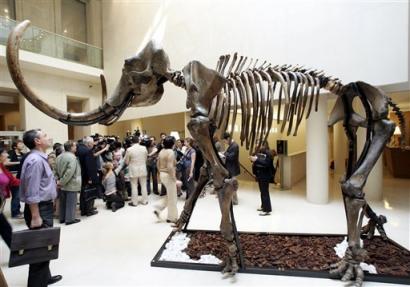
Mammoth skeleton sets auction record – Boston.com
On Monday, a rare Siberian mammoth skeleton sold for nearly half a million dollars at auction. The skeleton was inexplicably named “The President.”
A number of other curiosity-cabinet staples, like a bezoar, also sold, racking up a total of $1.5 million. The auction is a sign of increasing interest in natural history collectibles. Scientists complain such specimens shouldn’t be sold to private collectors, where they become inaccessible to researchers, but at these prices museums can’t compete. And as with early 20th century art, it seems provenance problems follow skyrocketing prices. A Russian official has challenged the origin of auctioned fossils.
PS. The first line of the Wikipedia article I linked for bezoar is perfectly indicative of the Wikipedia accessibility problem:
“A bezoar or enterolith is a sort of calculus or concretion, a stone found in the intestines of mostly ruminant animal.”
Oh, of course. I’m sure everyone gets it now. It’s something to do with math!

Concerning the sale of such fossiIs to private collectors, am not so much concerned by the accessibility problem to researchers. In many other fields (except painting it seems, saddly), most private collectors are usually prone to leave access to their rare pieces to researchers on request (this is the case for rare books, antique clocks, …). No, my real concern would rather be one of conservation. Conserving such fossils in a good state requires a good deal of technical knowledge, and carefully monitored atmospheric conditions. Who can be sure that the collector will spend the necessary money on those less “sexy” issues ? And what about his heirs when they inherit the piece ? This is the real concern to me.
When I was richer than I am now (in a former life), I used to spend good money on antiques. And one of the top sellers and experts in the Paris market told me once: “Never buy a piece which you cannot afford to conserve and restore properly; it is a matter of ethics”. This was a real eye-opener to me: with antiques of any kind, one not only buys an object, but one also “buys” a responsability towards the original maker of the piece, and towards future generations alike. When you hold a piece of art or craft in your hand, which was built 200 years ago and perfectly preserved until now, you really feel that responsability: the piece went through 7 or 8 generations, faced 6 or 7 wars, and is still there, pristine like on its very first day. Will I be the one who breaks this line ?
I do hope the collectors who bought these treasures are aware of this responsibility.
I had no idea that a calculus was a stone formed within the body, though I did know what a bezoar was. Just a small taste of the vagaries of my vocabulary 🙂